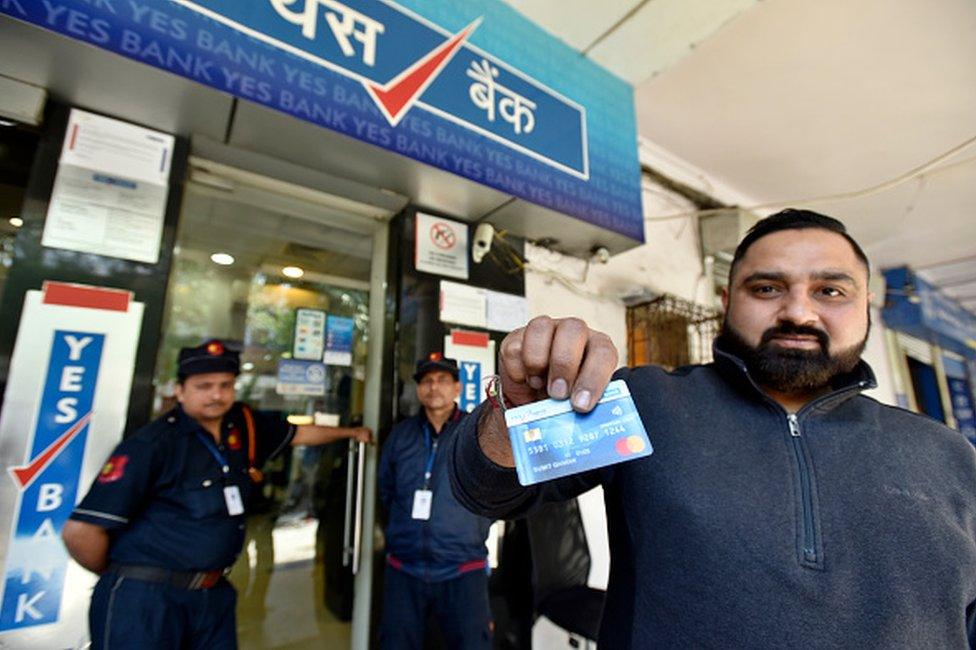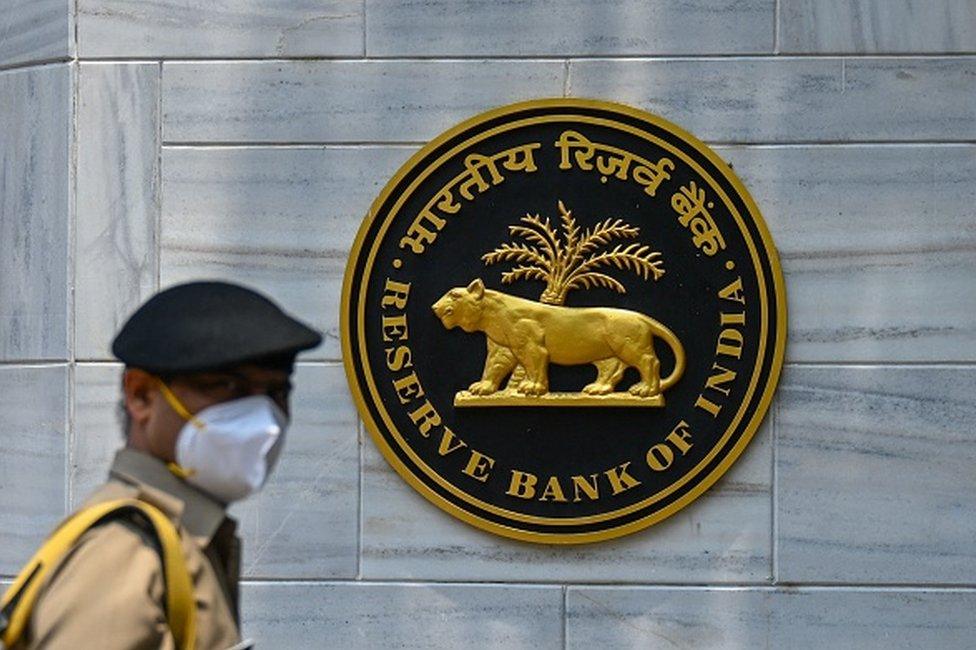'Bad bank' to clean up India's $27bn debt mountain
- Published

Yes Bank had to be rescued by India's central bank in 2020
With more than 150,000 branches loaded with $2tn (£1.46tn) worth of deposits and serving over a billion customers, India's banks look impressive on paper.
In reality, they are in a mess.
A clutch of banks is saddled with tens of billions of dollars of bad loans after years of injudicious lending to dud projects. State-owned banks account for more than 60% of the sour debt. Five banks have been rescued from collapse since 2018.
Bad loan recoveries have traditionally been low - up to a third of total loans - and have only improved a bit (40-45%) after a 2016 bankruptcy law which allows for liquidation of assets. And now borrowers hit by the pandemic could further default and add to the soaring debt in the coming months.
The bailouts - more than $35bn of taxpayers' money was injected to revive ailing banks between 2005 and 2009 alone - haven't helped much. In July last year, Fitch Ratings said India's struggling banks would need between $15bn-$58bn in infusion of fresh funds by 2022.
Now the government plans to float a long talked-about "bad bank" which will try to tame $27bn of bad loans and clean up the balance sheets of commercial banks.
This would still be a quarter of India's estimated $100bn of bad loans on the books of commercial banks. The resultant squeeze on credit has not only hobbled banking but undermined growth: private investments have nosedived as risk-averse banks are unwilling to lend freely.

Banks gave loans freely to dud real estate projects
A "bad bank" - also described as an asset reconstruction company - typically buys bad loans from affected banks at an agreed price. Then it liquidates or sells assets that borrowers have offered as securities against loans. The proceeds from the sales help the banks recoup some of the money they had lent to companies.
This is not the first time India has faced a bad loan crisis or launched a "bad bank". In fact, there have been 28 such firms, all privately owned, in the past two decades, but recoveries have been underwhelming.
This time, the government has formed two companies - one which will acquire the bad loans and will be state owned; and the other, partly privately owned, will try to sell the assets.
The government will pay the difference between the expected value of assets by the commercial bank and what the "bad bank" will be able to raise from the asset sales.
It will not be easy.
For one, the banks have to agree on valuations.
"Say there are 20 lenders in one company. All of them have to agree on many things. How much are the loans worth today? How much are the assets of the borrowers worth? Convincing a bank to sell loans at a loss is a challenge," says Anil Gupta, vice-president of financial sector ratings at ICRA, an investment and credit rating agency.
"Banks are usually skilled in lending but not recovery and resolution of bad loans."
Here, the second company will come into play.
It will bid for the assets of ailing and defunct companies: mainly land, plant and machinery, and some of it at scrap value. Half-a-dozen industries account for some 80% of the bad loans: they are in iron and steel, aviation, mining, roads, power and telecoms sectors.

India's central bank has been bailing out ailing commercial banks
Among the bouquet of 12 big defaulting firms - called "The Dirty Dozen' - are ones that used to make steel, textiles, infrastructure and ships; distribute electricity; develop real estate and build infrastructure. Some of their assets need to be sold, and that will be a challenge in a slowing economy.
In the long term, India needs to radically clean up its banking. At less than 60% India's credit to GDP ratio remains low, yet its banks have some of the highest non-performing loans in the world.
The loans began piling up between 2006 and 2008, when growth was buoyant and borrowing was easy. The global financial crisis of 2007-8 and the slowdown of growth left India relatively unscathed, and enthusiasm for investing didn't wane.
"Bad loans are sown in good times," says C Rangarajan, a former central bank governor.
This led, say experts, to a "classic case of irrational exuberance". A cocktail of high economic growth, even higher credit growth, low inflation, and a reduced fiscal deficit led to risk-taking by companies and banks, according to Tamal Bandyopadhyay, author of Pandemonium: The Great Indian Banking Tragedy.
Overconfident bankers did not do due diligence for many loans. Banks "lived on hope", giving fresh loans to book artificial profits by recovering interest on previous loans.
"India's crony capitalists used bank loans as both debt and equity to finance their projects. In a capitalist system, the businessman is expected to bring in the equity," says Mr Bandyopadhyay.
Experts say a "bad bank" will not be a magic bullet to cure what is a systemic problem with Indian banking.
State-owned banks will have to become truly independent, clean up their act and become more efficient lenders after accounting for market risks, and weighing their risk appetite. Improved regulation by India's central banks would help. Loan sales need more transparency.
"The bad bank is a step in the right direction," says Mr Gupta. "But only time will tell how it works out."
"My daughter can't study because my bank took my money" - report from November 2019
